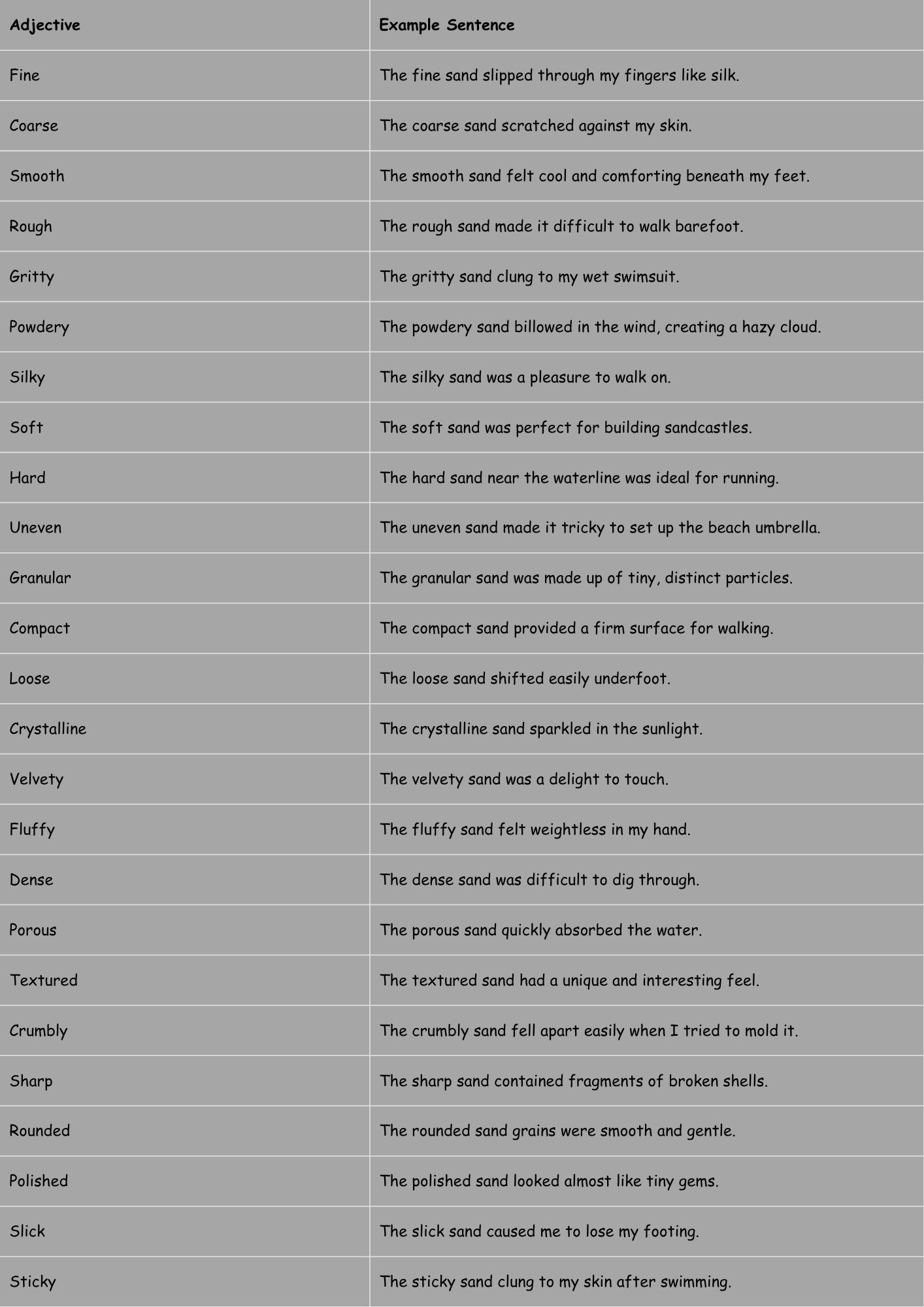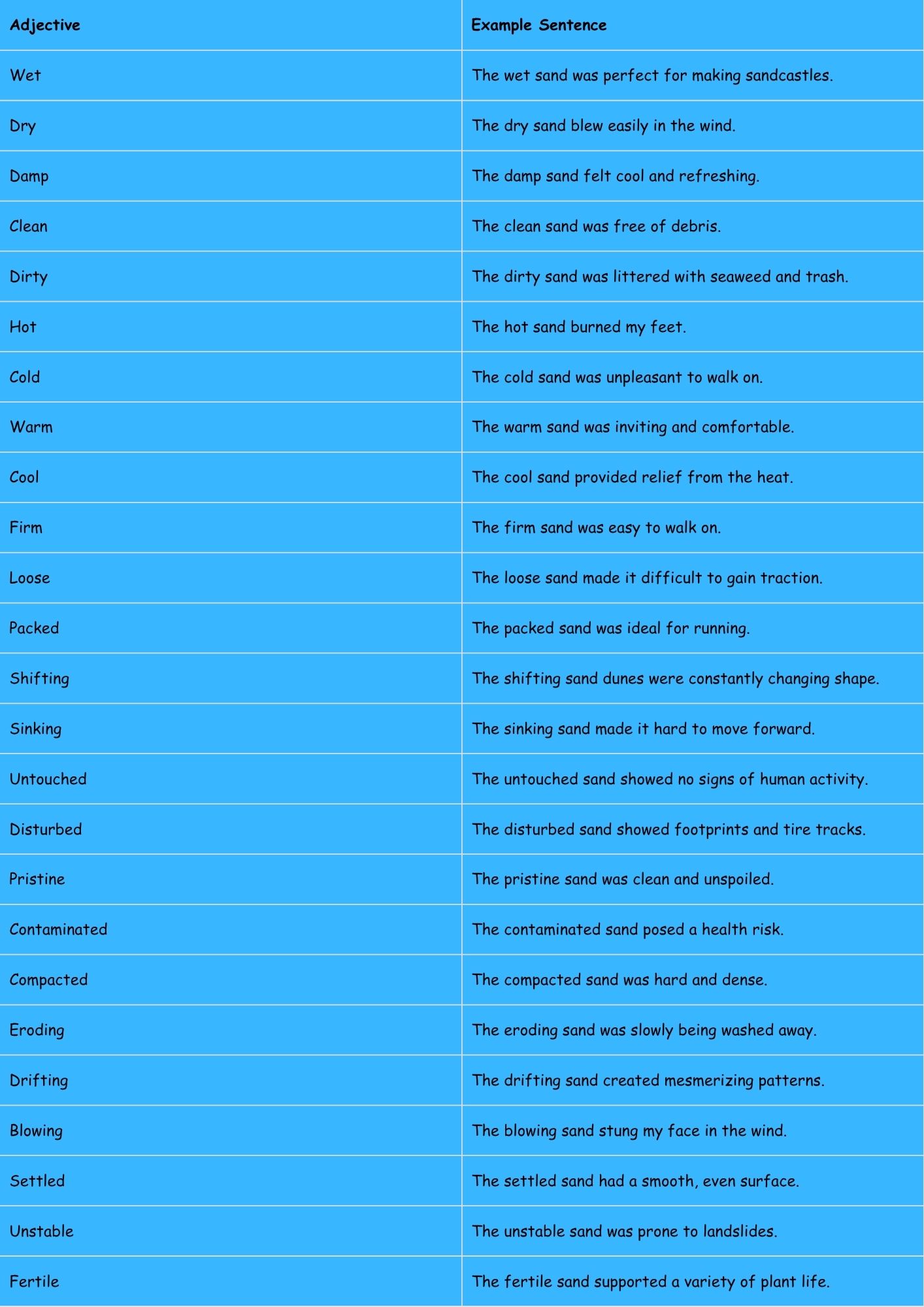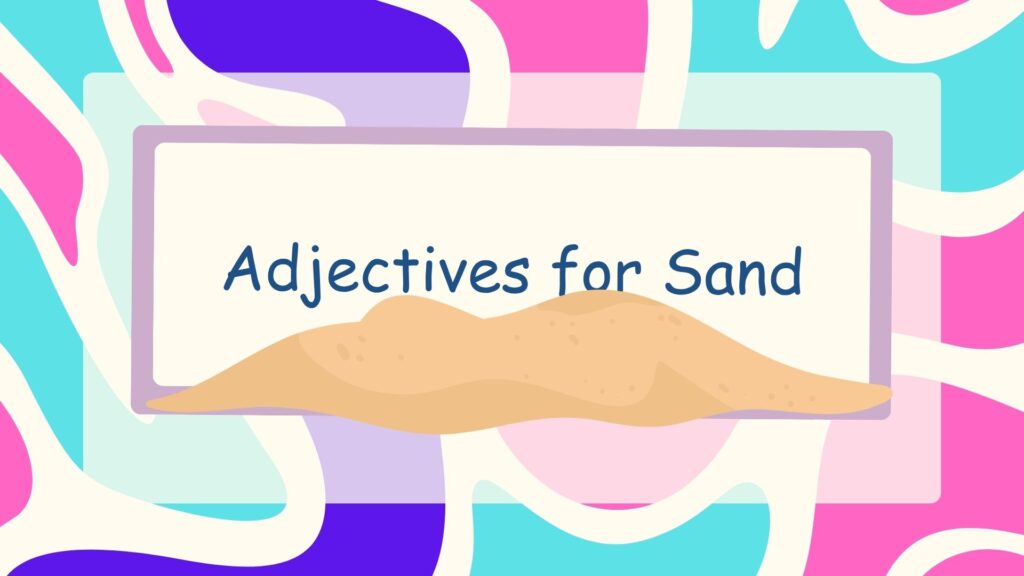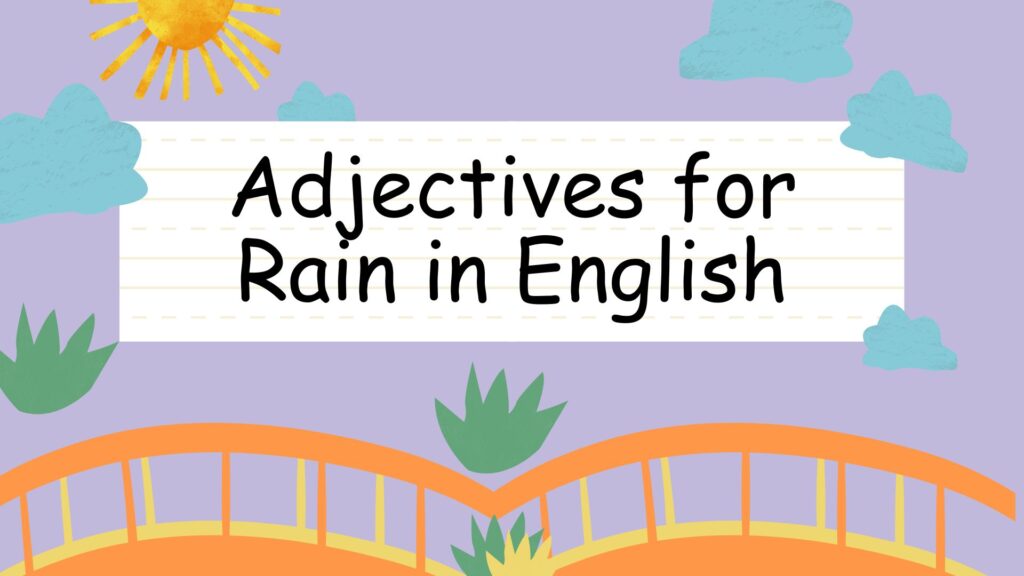mn vc cccccccccccccc Understanding how to use adjectives effectively is crucial for painting vivid pictures with words. When describing something as ubiquitous and varied as sand, a rich vocabulary of adjectives becomes essential. This article explores a wide range of adjectives that can be used to describe sand, covering aspects like texture, color, composition, and more. Whether you’re a student looking to improve your writing, a writer crafting a scene, or simply someone who appreciates the nuances of language, this guide will provide you with the tools to describe sand with accuracy and flair.
By delving into the diverse world of adjectives for sand, you’ll not only expand your vocabulary but also enhance your ability to evoke specific images and sensations in your audience. We will explore how different adjectives can change the perception of sand, from the rough grains of a desert landscape to the soft, powdery feel of a tropical beach. Through detailed explanations, examples, and practice exercises, you’ll master the art of choosing the perfect words to describe this versatile substance.
Table of Contents
- Introduction
- What are Adjectives?
- Structural Breakdown of Adjective Use
- Types of Adjectives for Sand
- Examples of Adjectives for Sand
- Usage Rules for Adjectives
- Common Mistakes with Adjectives
- Practice Exercises
- Advanced Topics
- Frequently Asked Questions
- Conclusion
What are Adjectives?
Adjectives are words that describe or modify nouns or pronouns. They provide additional information about the qualities, characteristics, or attributes of the nouns they modify. In essence, adjectives add detail and specificity, helping to create a more vivid and precise image in the reader’s mind. Understanding adjectives is fundamental to mastering English grammar and enhancing descriptive writing.
Adjectives can answer questions like: What kind? How many? Which one? For example, in the phrase “golden sand,” the adjective “golden” answers the question “What kind of sand?” It tells us about the color of the sand, providing a specific detail that enriches the description. Adjectives are versatile and can be used in various contexts to add depth and clarity to your writing.
There are several types of adjectives, including descriptive adjectives (beautiful, rough), quantitative adjectives (many, few), demonstrative adjectives (this, that), possessive adjectives (my, your), and interrogative adjectives (which, what). Each type serves a different purpose in modifying nouns and pronouns, allowing for a wide range of expressive possibilities.
Structural Breakdown of Adjective Use
Adjectives typically precede the noun they modify, as in “soft sand” or “warm sand.” However, they can also follow a linking verb (such as is, are, was, were, become, seem) to describe the subject of the sentence. For example, “The sand is fine” uses the adjective “fine” after the linking verb “is” to describe the sand.
Adjectives can also be modified by adverbs, which add another layer of detail. For instance, in the phrase “incredibly smooth sand,” the adverb “incredibly” modifies the adjective “smooth,” intensifying its meaning. This allows for even more precise and nuanced descriptions.
Multiple adjectives can be used to describe a single noun, but the order in which they appear is generally governed by certain conventions. These conventions, often referred to as the “order of adjectives,” dictate the sequence based on categories such as opinion, size, age, shape, color, origin, material, and purpose. Understanding this order can help you construct grammatically correct and aesthetically pleasing descriptions.
Types of Adjectives for Sand
When describing sand, different types of adjectives can be used to focus on specific characteristics. These include adjectives describing texture, color, composition, location, and condition. Each category provides a unique lens through which to view and describe sand.
Adjectives Describing Texture
Texture adjectives describe how the sand feels to the touch. These words are essential for conveying the tactile experience of interacting with sand. Examples include fine, coarse, smooth, rough, gritty, powdery, and silky.
Adjectives Describing Color
Color adjectives describe the hue of the sand. The color of sand can vary greatly depending on its composition and location. Examples include white, golden, brown, black, red, beige, and tan.
Adjectives Describing Composition
Composition adjectives describe what the sand is made of. This can include minerals, shells, and other materials. Examples include silica, coral, volcanic, quartz, shell, and mineral.
Adjectives Describing Location
Location adjectives describe where the sand is found or its association with a particular place. Examples include beach, desert, coastal, river, dune, and shoreline.
Adjectives Describing Condition
Condition adjectives describe the state or condition of the sand. This can include its moisture level, cleanliness, or temperature. Examples include wet, dry, damp, clean, dirty, hot, and cold.
General Descriptive Adjectives
General descriptive adjectives encompass a broader range of qualities that can be used to describe sand. These adjectives don’t fit neatly into the categories above but still provide valuable detail. Examples include vast, endless, beautiful, stretching, shifting, and untouched.
Examples of Adjectives for Sand
The following tables provide numerous examples of adjectives used to describe sand, organized by category. Each table includes a variety of adjectives and example sentences to illustrate their usage.
Texture Adjective Examples
This table provides examples of adjectives describing the texture of sand. These adjectives help to convey the tactile experience of interacting with sand.
| Adjective | Example Sentence |
|---|---|
| Fine | The fine sand slipped through my fingers like silk. |
| Coarse | The coarse sand scratched against my skin. |
| Smooth | The smooth sand felt cool and comforting beneath my feet. |
| Rough | The rough sand made it difficult to walk barefoot. |
| Gritty | The gritty sand clung to my wet swimsuit. |
| Powdery | The powdery sand billowed in the wind, creating a hazy cloud. |
| Silky | The silky sand was a pleasure to walk on. |
| Soft | The soft sand was perfect for building sandcastles. |
| Hard | The hard sand near the waterline was ideal for running. |
| Uneven | The uneven sand made it tricky to set up the beach umbrella. |
| Granular | The granular sand was made up of tiny, distinct particles. |
| Compact | The compact sand provided a firm surface for walking. |
| Loose | The loose sand shifted easily underfoot. |
| Crystalline | The crystalline sand sparkled in the sunlight. |
| Velvety | The velvety sand was a delight to touch. |
| Fluffy | The fluffy sand felt weightless in my hand. |
| Dense | The dense sand was difficult to dig through. |
| Porous | The porous sand quickly absorbed the water. |
| Textured | The textured sand had a unique and interesting feel. |
| Crumbly | The crumbly sand fell apart easily when I tried to mold it. |
| Sharp | The sharp sand contained fragments of broken shells. |
| Rounded | The rounded sand grains were smooth and gentle. |
| Polished | The polished sand looked almost like tiny gems. |
| Slick | The slick sand caused me to lose my footing. |
| Sticky | The sticky sand clung to my skin after swimming. |

Color Adjective Examples
This table provides examples of adjectives describing the color of sand. The color of sand can vary greatly depending on its mineral composition and origin.
| Adjective | Example Sentence |
|---|---|
| White | The white sand of the Caribbean beaches is breathtaking. |
| Golden | The golden sand shimmered in the afternoon sun. |
| Brown | The brown sand was typical of the beaches in that region. |
| Black | The black sand of the volcanic beach was strikingly beautiful. |
| Red | The red sand dunes stretched as far as the eye could see. |
| Beige | The beige sand blended seamlessly with the surrounding landscape. |
| Tan | The tan sand was warm beneath my feet. |
| Pink | The pink sand beach was a unique and unforgettable sight. |
| Gray | The gray sand reflected the overcast sky. |
| Creamy | The creamy sand felt luxurious against my skin. |
| Ivory | The ivory sand was pristine and untouched. |
| Sandy | The sandy colored dunes rose gently in the distance. |
| Ochre | The ochre colored sand had a unique earthy tone. |
| Russet | The russet sand was rich with iron deposits. |
| Mahogany | The mahogany sand was dark and exotic. |
| Charcoal | The charcoal sand was the result of ancient volcanic activity. |
| Silver | The silver sand sparkled like precious metal. |
| Bronze | The bronze sand had a metallic sheen. |
| Copper | The copper sand was rich in mineral content. |
| Multicolored | The multicolored sand was a mix of various minerals. |
| Speckled | The speckled sand had flecks of different colors. |
| Variegated | The variegated sand showed a range of hues. |
| Pale | The pale sand was almost white in color. |
| Dark | The dark sand absorbed the heat of the sun. |
| Light | The light sand reflected the sunlight brilliantly. |
Composition Adjective Examples
This table provides examples of adjectives describing the composition of sand, focusing on the materials it is made of.
| Adjective | Example Sentence |
|---|---|
| Silica | The silica sand was primarily composed of quartz crystals. |
| Coral | The coral sand was made up of fragments of broken coral. |
| Volcanic | The volcanic sand was dark and rich in minerals. |
| Quartz | The quartz sand sparkled in the sunlight. |
| Shell | The shell sand crunched under my feet. |
| Mineral | The mineral sand contained a variety of colorful particles. |
| Granite | The granite sand was coarse and speckled. |
| Basalt | The basalt sand was dark and dense. |
| Limestone | The limestone sand was white and powdery. |
| Feldspar | The feldspar sand had a pinkish hue. |
| Calcareous | The calcareous sand was rich in calcium carbonate. |
| Sedimentary | The sedimentary sand was formed over millions of years. |
| Organic | The organic sand contained decomposed plant matter. |
| Inorganic | The inorganic sand was primarily composed of minerals. |
| Pebbly | The pebbly sand made walking difficult |
| Rocky | The rocky sand was not suitable for building sandcastles. |
| Gravelly | The gravelly sand was a mixture of sand and small stones. |
| Silty | The silty sand was fine and easily disturbed. |
| Clayey | The clayey sand was sticky when wet. |
| Iron-rich | The iron-rich sand had a reddish color. |
| Mica | The mica sand sparkled with flakes of reflective minerals. |
| Olivine | The olivine sand had a greenish tint. |
| Garnet | The garnet sand was dotted with tiny red gemstones. |
| Dolomite | The dolomite sand was composed of magnesium-rich minerals. |
| Pyrite | The pyrite sand sparkled with fool’s gold. |
Location Adjective Examples
This table provides examples of adjectives describing the location or environment where the sand is found.
| Adjective | Example Sentence |
|---|---|
| Beach | The beach sand was perfect for sunbathing. |
| Desert | The desert sand stretched endlessly into the horizon. |
| Coastal | The coastal sand was constantly reshaped by the waves. |
| River | The river sand was deposited along the banks. |
| Dune | The dune sand shifted with the wind. |
| Shoreline | The shoreline sand was damp and cool. |
| Ocean | The ocean sand was home to many tiny creatures. |
| Island | The island sand was pristine and untouched. |
| Lagoon | The lagoon sand was calm and clear. |
| Seaside | The seaside sand was filled with the scent of salt air. |
| Tropical | The tropical sand was warm and inviting. |
| Temperate | The temperate sand was cooler and less humid. |
| Arctic | The arctic sand was frozen for much of the year. |
| Continental | The continental sand was found far from the coast. |
| Inland | The inland sand was drier and less salty. |
| Cliffside | The cliffside sand was eroding slowly. |
| Subterranean | The subterranean sand was hidden beneath the surface. |
| Volcanic | The volcanic sand was a result of lava flows. |
| Glacial | The glacial sand was deposited by melting ice. |
| Estuarine | The estuarine sand was a mix of fresh and salt water. |
| Bay | The bay sand was sheltered from the open sea. |
| Delta | The delta sand was rich in nutrients. |
| Atoll | The atoll sand formed a ring around the lagoon. |
| Barrier | The barrier sand protected the mainland from the sea. |
| Cove | The cove sand was hidden and secluded. |
Condition Adjective Examples
This table provides examples of adjectives that describe the condition or state of the sand.
| Adjective | Example Sentence |
|---|---|
| Wet | The wet sand was perfect for making sandcastles. |
| Dry | The dry sand blew easily in the wind. |
| Damp | The damp sand felt cool and refreshing. |
| Clean | The clean sand was free of debris. |
| Dirty | The dirty sand was littered with seaweed and trash. |
| Hot | The hot sand burned my feet. |
| Cold | The cold sand was unpleasant to walk on. |
| Warm | The warm sand was inviting and comfortable. |
| Cool | The cool sand provided relief from the heat. |
| Firm | The firm sand was easy to walk on. |
| Loose | The loose sand made it difficult to gain traction. |
| Packed | The packed sand was ideal for running. |
| Shifting | The shifting sand dunes were constantly changing shape. |
| Sinking | The sinking sand made it hard to move forward. |
| Untouched | The untouched sand showed no signs of human activity. |
| Disturbed | The disturbed sand showed footprints and tire tracks. |
| Pristine | The pristine sand was clean and unspoiled. |
| Contaminated | The contaminated sand posed a health risk. |
| Compacted | The compacted sand was hard and dense. |
| Eroding | The eroding sand was slowly being washed away. |
| Drifting | The drifting sand created mesmerizing patterns. |
| Blowing | The blowing sand stung my face in the wind. |
| Settled | The settled sand had a smooth, even surface. |
| Unstable | The unstable sand was prone to landslides. |
| Fertile | The fertile sand supported a variety of plant life. |

Usage Rules for Adjectives
Using adjectives correctly involves understanding their placement in relation to the nouns they modify, as well as the order in which multiple adjectives should appear. There are general guidelines that help ensure clarity and grammatical correctness.
Adjective Order
When using multiple adjectives to describe a noun, there is a general order to follow. This order helps ensure that the description sounds natural and is easily understood. While not a strict rule, it’s a helpful guideline. The typical order is: Opinion, Size, Age, Shape, Color, Origin, Material, and Purpose (OSASCOMP).
For example, instead of saying “a brown large old table,” the correct order would be “a large old brown table.” This follows the order of Size, Age, and Color.
Coordinate Adjectives
Coordinate adjectives are adjectives that modify the same noun equally. They can be separated by a comma or the word “and.” To determine if adjectives are coordinate, you can try reversing their order or inserting “and” between them. If the sentence still makes sense, they are coordinate.
For example, in the phrase “a warm, sunny beach,” “warm” and “sunny” are coordinate adjectives. You could also say “a sunny, warm beach” or “a warm and sunny beach” without changing the meaning.
Cumulative Adjectives
Cumulative adjectives build upon each other to modify the noun. They cannot be separated by a comma or the word “and,” and their order is important. Reversing their order would change the meaning or sound unnatural.
For example, in the phrase “a beautiful old wooden house,” “beautiful,” “old,” and “wooden” are cumulative adjectives. You cannot say “an old beautiful wooden house” or “a beautiful and old wooden house” without sounding awkward or changing the intended meaning.
Common Mistakes with Adjectives
One common mistake is using adjectives incorrectly or in the wrong order. For example, saying “a red big ball” instead of “a big red ball” is a frequent error. Another mistake is misusing adjectives as adverbs, such as saying “He runs quick” instead of “He runs quickly.”
Another common error is using too many adjectives, which can make the writing sound cluttered and overwhelming. It’s important to choose adjectives carefully and use only those that add significant detail and enhance the description.
Here are some examples of common mistakes and their corrections:
| Incorrect | Correct | Explanation |
|---|---|---|
| The sand was hot very. | The sand was very hot. | Adverb “very” should precede the adjective “hot.” |
| A small blue old car. | A small old blue car. | Adjectives should follow the correct order (Size, Age, Color). |
| He felt badly about the dirty sand. | He felt bad about the dirty sand. | “Bad” is the correct adjective to describe a feeling. |
| The beach was beauty. | The beach was beautiful. | “Beautiful” is the adjective form of “beauty.” |
| I saw three cat. | I saw three cats. | The noun must be plural to agree with the number. |
Practice Exercises
These practice exercises will help you reinforce your understanding of adjectives for sand. Each exercise focuses on a different aspect of adjective usage, from identification to selection and sentence completion.
Exercise 1: Identifying Adjectives
Identify the adjectives in the following sentences.
- The golden sand shimmered under the sun.
- The rough, gritty sand hurt my feet.
- We built a large sandcastle on the beach.
- The wet sand was perfect for molding.
- The desert landscape was covered in sand.
- The fine sand slipped through my fingers.
- The black sand was unique to this beach.
- The wind swept across the endless dunes.
- The warm sand felt good against my skin.
- The coastal breeze carried the smell of salt.
Answers:
- golden
- rough, gritty
- large
- wet
- desert
- fine
- black
- endless
- warm
- coastal
Exercise 2: Choosing the Right Adjective
Choose the best adjective from the options provided to complete each sentence.
- The ______ sand was soft and powdery. (a) coarse (b) fine (c) rough
- The beach had ______ sand due to volcanic activity. (a) white (b) golden (c) black
- The ______ sand was difficult to walk on because it kept shifting. (a) firm (b) loose (c) packed
- The ______ sand was made up of tiny pieces of coral. (a) silica (b) coral (c) mineral
- The ______ sand near the ocean was damp and cool. (a) desert (b) coastal (c) river
- The ______ sand was heated by the sun and was hot to the touch. (a) cold (b) warm (c) hot
- The ______ sand made it easy to build a sturdy sandcastle. (a) wet (b) dry (c) damp
- The ______ sand dunes stretched for miles in the desert. (a) ocean (b) dune (c) river
- The ______ sand was perfect for sunbathing and relaxing. (a) beach (b) desert (c) coastal
- The ______ sand had a unique reddish color due to iron deposits. (a) white (b) red (c) black
Answers:
- b
- c
- b
- b
- b
- c
- a
- b
- a
- b
Exercise 3: Sentence Completion
Complete the following sentences with appropriate adjectives to describe the sand.
- The sand felt __________ beneath my feet.
- We walked along the __________ beach.
- The children played in the __________ sand.
- The __________ dunes rose majestically in the distance.
- The color of the sand was a __________ shade.
- The texture of the sand was surprisingly __________.
- The sand was __________ due to the recent rain.
- The __________ sand sparkled in the sunlight.
- The __________ sand was filled with tiny shells.
- The __________ beach was a popular spot for tourists.
Possible Answers:
- The sand felt warm beneath my feet.
- We walked along the sandy beach.
- The children played in the soft sand.
- The rolling dunes rose majestically in the distance.
- The color of the sand was a golden shade.
- The texture of the sand was surprisingly smooth.
- The sand was damp due to the recent rain.
- The quartz sand sparkled in the sunlight.
- The shell sand was filled with tiny shells.
- The popular beach was a popular spot for tourists.
Advanced Topics
For advanced learners, exploring figurative language and literary devices involving adjectives for sand can add depth and sophistication to your writing. This includes understanding metaphors, similes, and personification, and how they can be used to create vivid imagery and convey complex emotions.
Figurative Language with Sand Adjectives
Using figurative language with adjectives for sand can create powerful and evocative descriptions. For example, describing sand as “velvety” is a metaphor that compares its texture to the smoothness of velvet. Similarly, saying the sand is “as golden as honey” is a simile that uses comparison to enhance the description.
Literary Devices and Sand
Literary devices such as personification can also be used with adjectives for sand. For example, describing the “shifting” sand as “restless” personifies it by attributing human qualities. These techniques can elevate your writing and make it more engaging and memorable.
Frequently Asked Questions
- What is the correct order of adjectives when describing sand?The general order is Opinion, Size, Age, Shape, Color, Origin, Material, and Purpose (OSASCOMP). For example, “a beautiful, fine, golden beach.”
- Can I use multiple adjectives of the same type?Yes, but use them sparingly. Too many adjectives can clutter your writing. Choose the most impactful ones. For example, instead of saying “a soft, smooth, silky sand,” you might choose just “silky sand.”
- How do I avoid overusing adjectives?Focus on strong nouns and verbs. Sometimes, a well-chosen noun or verb can convey more meaning than an adjective. Also, get feedback from others to see if your writing sounds too descriptive.
- Are there any adjectives that should be avoided when describing sand?Avoid clichés and overly generic adjectives like “nice” or “good.” Instead, opt for more specific and descriptive words that paint a clearer picture.
- How can I make my descriptions of sand more creative?Experiment with figurative language, such as metaphors and similes. Think about the sensory details – how the sand feels, looks, smells, and even sounds. Use vivid verbs and nouns to support your adjectives.
Conclusion
Mastering the use of adjectives for sand can significantly enhance your descriptive writing. By understanding the different types of adjectives, their proper usage, and common mistakes to avoid, you can create vivid and engaging descriptions that capture the essence of this versatile substance. Whether you’re writing a novel, a poem, or simply trying to improve your communication skills, a rich vocabulary of adjectives will serve you well.
Remember to practice regularly and experiment with different combinations of adjectives to find what works best for you. Pay attention to the order of adjectives, avoid overuse, and don’t be afraid to get creative with figurative language. With dedication and attention to detail, you can master the art of describing sand and bring your writing to life.



